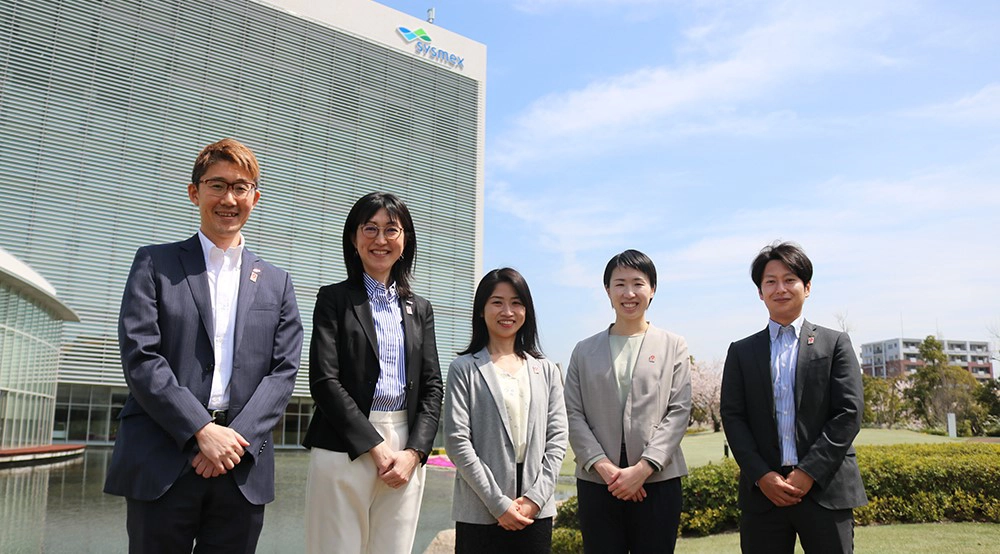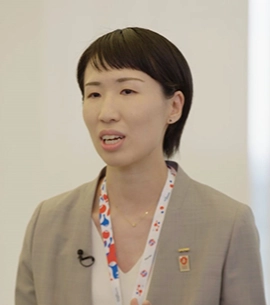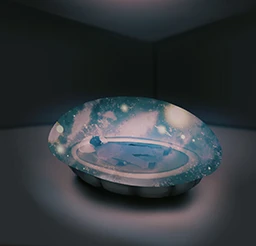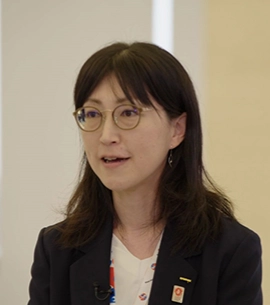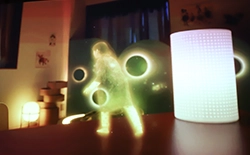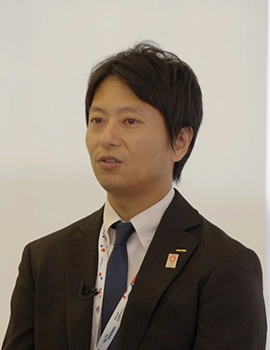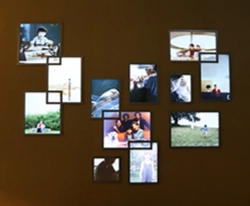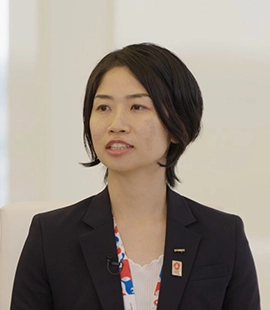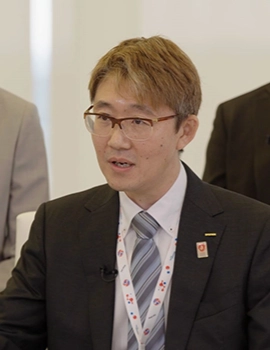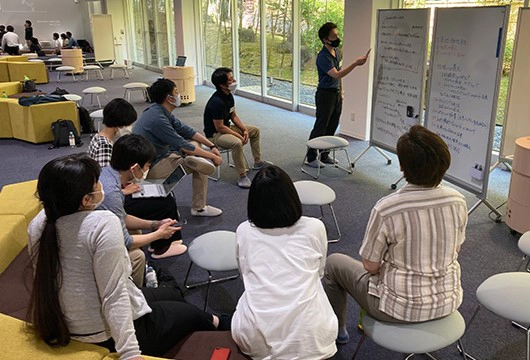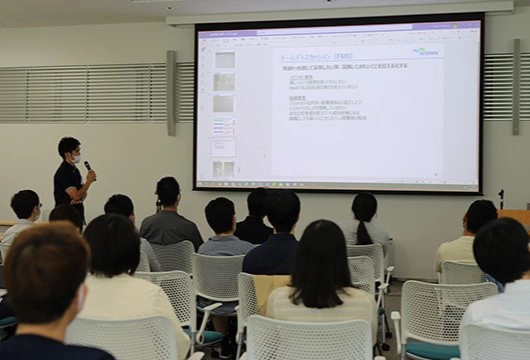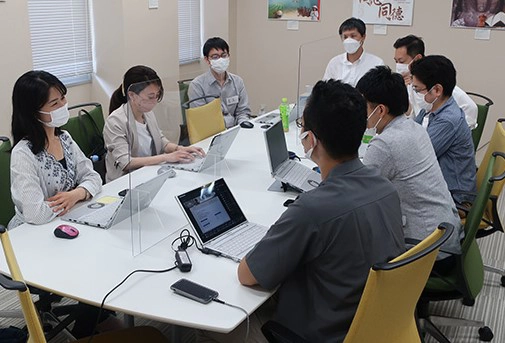In 2075, what will “life” mean to us?
Sysmex is a silver partner sponsor of the Signature Pavilion “Future of Life” at Expo 2025 Osaka, Kansai, Japan (hereafter, “the Expo”), produced by Professor Hiroshi Ishiguro of The University of Osaka, a leading authority in robotics. Inspired by Professor Ishiguro’s wish for sponsoring companies to envision the future together, Sysmex joined this co-creation project to explore what society and life might look like 50 years from now.
Around 50 employees from across divisions, occupations, and generations voluntarily came together to launch the in-house project. After three years of dialogue and trial and error, they developed ideas for three products to support the future of life.
In this article, five key project members will reflect on their journey.
Left to right: Takamichi Naito, DX Strategy Development; Akiko Adachi, Next Generation Medical Business Development; Mayuko Kobayashi, LS Business; Tomoko Saito, Sysmex R&D Center Europe GmbH; Masaya Okada, Central Research Laboratories
The Challenge of Envisioning the Future: Why the Mind Matters
Early in the discussions, one perspective that stood out was: “In the future of healthcare, won’t caring for the mind be just as important?”
Until now, Sysmex’s efforts have focused primarily on the body. But in this project, we stepped beyond that framework to explore mental and emotional healthcare as well. By tackling abstract questions with no clear answers, we began shaping concepts for products that support the future of life.
Saito: Fifty years from now, in a future where advances in preventive medicine and treatment technologies have dramatically extended lifespans, caring not just for the body but also for the mind will become even more important. That idea was our starting point. From there, we kept returning to questions like “What is a healthy mind?” and “How can we achieve this?”
I don’t think we could have explored the concept of life so deeply if we’d only discussed it with the people we normally work with. By respecting—and sometimes clashing with—project members who had different perspectives, we were able to have honest, in-depth discussions. I believe that process gave us the strength to envision the future.
The Visions Behind Three Future Products
Three future products appear in the pavilion. What kind of discussions led to these ideas? Members who helped guide those conversations share the story.
“Another Story” — Living Alternate Lives Through Dreams
Another Story is a dome-shaped device in which users sleep and experience diverse situations in their dreams, as if watching a movie. It enables users to broaden their mind horizons and, by helping them in their decision-making and behavior, support them in living the best life possible.
Adachi: Today, sleep is a passive act, something we simply do out of necessity. We imagined a future where this time could be used more actively. We came up with a system to reinforce positive thinking habits through dreams and support people in making satisfying decisions amid uncertainty. That said, only experiencing pleasant dreams could risk narrowing one’s emotional range. So, we deliberately incorporated stories with bad endings or failures to help strengthen the mind.
As a distinctly Sysmex approach, we also included a perspective that looks at both the body and the mind. Inside the dome, the system closely monitors factors like heart rate, body temperature, and even changes at the cellular level to provide an optimized dream experience.
“KaraKoro Speak” — Conveying Feelings Beyond Words
KaraKoro Speak enables a new form of communication unrestricted by the physical body. Through a holographic avatar projected from a microchip attached to the body, users can seamlessly express their mind to others and deepen their self-reflection.
Okada: By 2075, communication is expected to become even more complex. With virtual reality (VR) and advanced mobility, the distance between people will shrink, creating a society where diverse values coexist.
KaraKoro Speak aims to meet these challenges by expressing users’ thoughts and emotions, supporting a form of communication deeply connected to the heart. It can be used not only group conversations or exchanges between doctors and patients where tension and language barriers exist, but also for dialogue with oneself, helping to organize thoughts and manage stress. It might even enable communication with babies or animals, expanding the possibilities of interaction.
We focused on the concept of an avatar representing the user’s thoughts. We believe this holds great potential as a new form of communication and could significantly contribute to future mental healthcare.
“Vision Diary” — Comparing “What If” Scenarios to Expand Life’s Choices
Vision Diary measures the mind and physical attributes of the user and their family, then simulates their bodies, minds, and lifestyles. It can lessen worries about the future and broaden life choices. In this way, the device encourages the user and their family to make appropriate life choices.
Kobayashi: After returning from parental leave, I became involved in this project and wanted to create an exhibit where people could discuss the future together with their children. We came up with a tool that uses physical and mental measurement data to present multiple future scenarios of oneself and family like a picture diary, encouraging positive choices. Rather than showing one correct answer, it’s designed to let users compare several “what if” scenarios, helping them discover their own values, true feelings, and untapped potential. By deliberately not showing overly detailed analysis results, it emphasizes the process of independently thinking through and choosing actions.
Personally, I’d like to use it when I’m uncertain, as a way to encourage myself to take on more challenges.
The Realization of 50 Sysmex Employees: The Future Is Something We Create for Ourselves
In a future where extended healthy lifespans are the norm, people will seek not only to cure illness but to live better. At that time, the very definition of healthcare may change.
Naito: At first, I was somewhat overwhelmed by the freedom involved in envisioning a future 50 years from now. However, ideas like healthcare in space and using dreams, along with our collaborations with Professor Ishiguro and other companies, became valuable experiences that expanded our thinking.
All 50 project members realized the future isn’t set in stone; it’s something we create ourselves. We also gained insights, diverse perspectives, and connections across departments and companies that now support our future challenges. Each employee’s awareness and behavior are already shifting, positively influencing their daily work. I believe these changes will help shape Sysmex’s corporate culture going forward.
The Expo also provides a platform to raise future social issues with the next generation.I hope many will experience the Signature Pavilion “Future of Life” and use it as an opportunity to reflect on their own futures.
The experience from this project is invaluable and marks a major step toward the future. We will continue challenging ourselves to advance healthcare.
*The three future products featured in this story are conceptual and not currently under development or planned for release by our company.
Related Keywords
- Information contained in the stories is current as of the date of the announcement,
but may be subject to change without prior notice.
